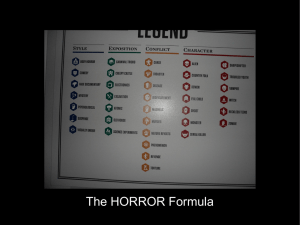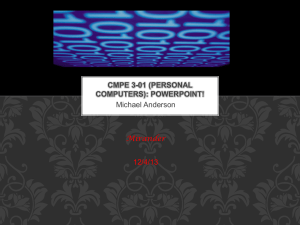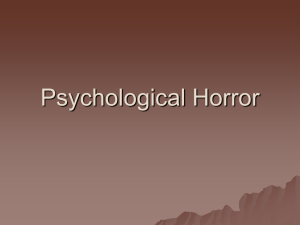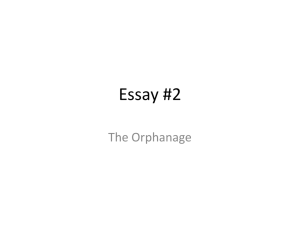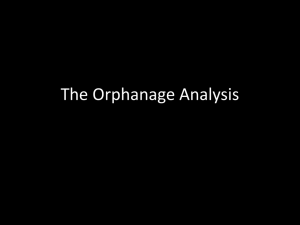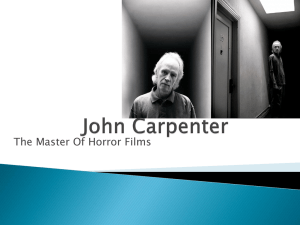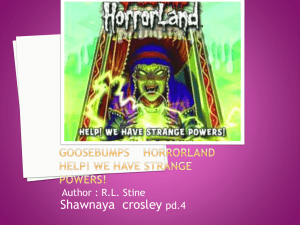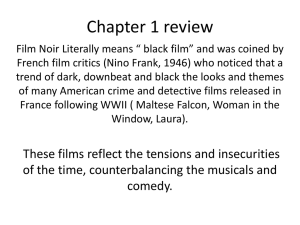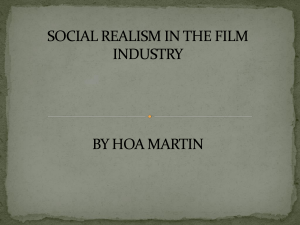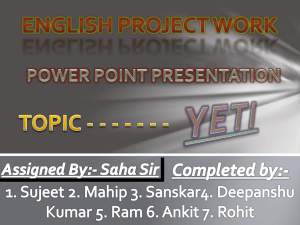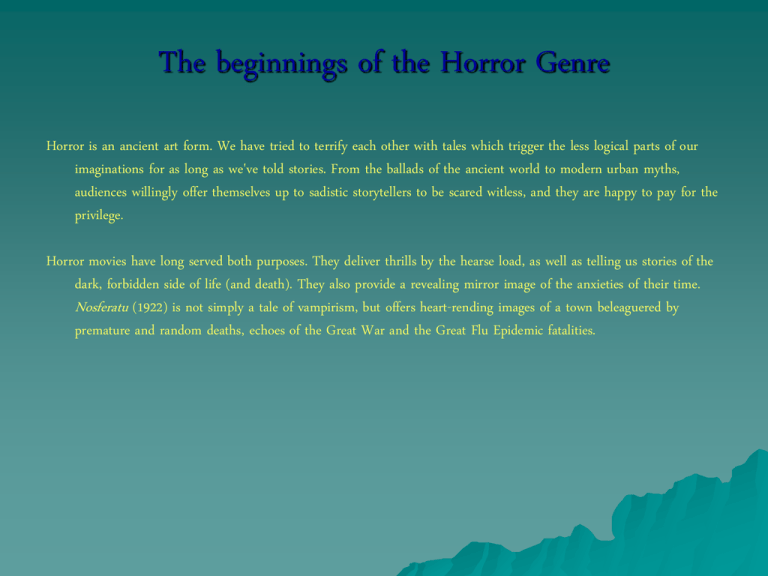
The beginnings of the Horror Genre
Horror is an ancient art form. We have tried to terrify each other with tales which trigger the less logical parts of our
imaginations for as long as we've told stories. From the ballads of the ancient world to modern urban myths,
audiences willingly offer themselves up to sadistic storytellers to be scared witless, and they are happy to pay for the
privilege.
Horror movies have long served both purposes. They deliver thrills by the hearse load, as well as telling us stories of the
dark, forbidden side of life (and death). They also provide a revealing mirror image of the anxieties of their time.
Nosferatu (1922) is not simply a tale of vampirism, but offers heart-rending images of a town beleaguered by
premature and random deaths, echoes of the Great War and the Great Flu Epidemic fatalities.
Horror in the 1940’s
In the early 1940s, a world living under the shadow of Hitler's predatory tendencies identified a part-man, part-wolf
whose bestial nature caused him to tear apart those who crossed his path as their bogeyman.
In the 1990s however, there was no need for a part wolf component: Jonathan Doe (Se7en 1994) and Hannibal Lecter
(Manhunter 1986, Silence of the Lambs 1991, Hannibal 2001) were entirely human in their calculated and stylised
killing methods. As we move on into the twenty first century, the ghosts and zombies are back in vogue as Eastern
and Western superstitions converge.
So where did the genre originate from?
Some of the greatest mid- nineteenth century novelists tried their hand at horror fiction, paying tribute to the dying
traditions of the gothic.
Emily Bronte steeped her novel Wuthering Heights in gothic situations and sensibilities.
Dickens wrote a number of ghost stories (the best perhaps being The Signalman, the best known A
Christmas Carol).
Herman Melville incorporated many supernatural elements into Moby Dick, as did Nathaniel Hawthorne with
The Scarlet Letter and The House of the Seven Gables.
Early horror
Silent film offered the early pioneers a wonderful medium in which to examine terror.
Early horror films are surreal, dark pieces, owing their visual appearance to the expressionist painters. Darkness and
shadows, such important features of modern horror, were impossible to show on the film stock available at the time,
so the sequences, for example in Nosferatu, where we see a vampire leaping amongst gravestones in what appears to
be broad daylight, seem doubly surreal to us now.
Sound & horror
The advent of sound, as well as changing the whole nature of cinema forever, had a huge impact on the
horror genre. The dreamlike imagery of the 1920s, the films peopled by ghosts floating silently through the
terror of mortals, were replaced by monsters that grunted and groaned and howled.
Sound adds an extra dimension to terror, whether it be music used to build suspense or signal the presence of
a threat, or magnified footsteps echoing down a corridor.
Horror, with its strong elements of the fantastic and the supernatural, provided an effective escape to
audiences tiring of their Great Depression reality, and, despite the money spent on painstaking special effects,
often provided a good return for their studio.
Horror & the war
Wartime horror movies were purely an American product. Banned in Britain, with film production curbed throughout
the theatre of war in Europe, horror movies were made in Hollywood purely in response to the domestic audience.
No risks could be taken, so the studios stuck with tried and tested ideas. This was not an age of innovation If the horror
movies of the 1930s had dealt in well-established fictional monsters, looking back towards the nineteenth century for
inspiration, the 1940s reflected the internalisation of the horror market.
Hitchcock & horror
Although there are moments in all his major works that cross the line between horror and thriller it is only Psycho
(1960) and The Birds (1963) that can truly be described as horror films. He proved himself expert at scaring
audiences with both an internal and external threat.
Psycho presented us with Norman Bates, the monster so close to normal it was only in the final section of the film that
he revealed how monstrous a man could be.
Psycho has become iconic in a way few other movies have ever become. Everyone "knows" the story; the name Norman
Bates is familiar to those who have never seen the film.
The screeching soundtrack and the flashing of the knife blade in the shower scene seem condemned to perpetual
rerunning in horror films to this day.
Hitchcock & horror
Hitchcock & horror
The Birds, Daphne du Maurier's short story was originally set in Cornwall. Hitchcock transposed it to Bodega Bay,
California, and turned a simple tale of the malevolence at the heart of nature into a morality play.
Melanie Daniels (Tippi Hedren) is a bad girl. The extent of her badness is never fully revealed, but we know that she has
spent her time frolicking naked in fountains in Rome, and impersonating pet shop assistants in San Francisco. She
is also prepared to clear her diary and follow home a man she fancies. Her arrival in Bodega Bay, in hot pursuit of
Mitch, coincides with the beginnings of strange behaviour from the birds.
Hitchcock & horror
Later in the movie a townswoman screams at her "What are you?", blaming her for the catastrophe. Melanie does not
answer.Whoever or whatever has caused them to attack, the birds are fearsome opponents.
A variety of special effects (much blue screen work and some animation provided by Disney technicians) plus the spooky
soundtrack - a combination of deathly silence and artificial bird noises - create a many-headed monster, flapping
and screeching and pecking.
Hammer Horror
Horror had been established by the monster movies of a decade earlier as a low budget, high grossing genre: the audience's seemingly
insatiable demand for thrills combined with a willingness to suspend disbelief meant that there was a steady stream of production.
In Britain, Hammer Films produced a slew of horror pictures, becoming known as Hammer, House of Horror.
Although their first real success was The Quatermass Experiment(1955), a sci-fi venture, they soon decided that monsters in human
form were better... and cheaper! Also, the glut of monster pictures in the 1950s meant that audiences, as ever, sought a new
direction. or an old one. Hammer began to rehash all the horror stories so beloved of Universal in the 1930s: Dracula,
Frankenstein, The Mummy etc etc, but added a touch of erotica.
Hammer Horror
Hammer Horror
Whereas the Universal movies were wholesome family fare, Hammer prided themselves on their 'X- ADULT ONLY'
certification. That X-rating was earned by a soft-focus erotic flavour which seems curiously chivalrous to us now,
but was very daring in a world that had not long left the Hay's Code behind.
Peter Cushing and Christopher Lee were played a succession of villains and monsters. They too have become paradigms
of the genre.
Horror in 1970’s
One genuine fear apparent in the horror films of the 1970s is the fear of children, and the fear of the messy, painful and
often fatal process of childbirth.
Children are the focus of horror in many key 1960s films. They are unwanted and do bad things to their parents,
culminating in Rosemary's Baby. Yet this theme dominates the 1970s, as the crumbling family unit becomes the
source of much fear and mistrust.
It's your Mum (Shivers). Your Dad (The Shining). Your brother (Halloween). Your husband (The Stepford Wives).
Your little boy (The Omen). Your daughter (The Exorcist). It's the people you see so often you don't really see
them any more (Carrie). The seventies were about deep-seated paranoia, and the fear that the moral shift of the
1960s had created a culture of monsters - the archetypal successors of the shuffling zombies in Night of The Living
Dead.
Horror in 1970’s
Horror in 1970’s
The 1970s is also the decade when the first so called movie brats (the first generation to grow up with television and the
level of visual literacy that brings) leave film school and get let loose on their own movies (Spielberg, Scorsese,
Lucas, de Palma et al). Also, writer Stephen King hits the bestseller lists with his 1974 debut, Carrie. These are
people who grew up watching the Universal horror classics and The Addams Family on TV.
They knew intimately how a horror film should look and how a monster should behave - and how a skilled director
might start playing variations on the well worn themes.
Steven Spielberg took the well-worn theme of the monster movie ("It's coming to get you! Run! Hide!") and produced
the sublime Jaws (1975), proving his worth as a director even with a budget of $12M.
Horror in the 1980’s
The horror films of the early 1980s show a new energy and delight in the genre, as special effects creators
fell over each other to create sequences that had never been attempted on film before. There were to be
no more monsters with zippers up the back.
Towards the end of the decade, horror movies were considerably 'dumbed down' to attract their target
audience, with body counts through the ceiling, and little attention being paid towards plot and
credibility.
Friday the 13th (1980), the first of the horror genre's most recognizable horror series - with an astonishing
number of sequels (ten), ripped off more original films of the 70s with tales of terrorized teen camp
counsellors. It also inspired a TV series and several spoofs. Jason, like the psychopathic Freddy Krueger
before him in the Nightmare on Elm Street series, became a landmark name.
Horror in the 1980’s
Horror in the 1990’s
By the end of the 1980s horror had become so reliant on gross-out gore and buckets of liquid latex that it seemed to
have lost its power to do anything more than shock and then amuse.
The 1990’s got the thing they feared the most, the serial killer
Top Horror/Serial Killer of 1990’s
Silence of The Lambs (1990)
Scream (1996)
Se7en (1995)
Blair Witch Project (1999)
Blade (1999)
The Sixth Sense (1999)
Misery (1990)
Horror in the 1990’s
The Horror Film & audience
Horror films tend to be viewed with critical disdain for a number of reasons:
Predictability of form and content
Low budgets and poor production values
Targeting an adolescent audience
Variety of generic sources and subgenres
Fantasy worlds – little connection with social or political issues
Dependence upon blood, gore, viscera for effect
Conservative attitudes towards morality and sexuality
The Horror Film
“The horror film has consistently been one of the most popular
and, at the same time, the most disreputable of Hollywood
genres. The popularity itself has a peculiar characteristic that sets
the horror film apart from other genres: it is restricted to
aficionados and complemented by total rejection, people tending
to go to horror films either obsessively or not at all”
Robin Wood, American Nightmare
Why are horror films popular with audiences?
Stability of form and content provides a predictable set of pleasures
Ability to merge with other genres eg crime, sci-fi
Emphasis on the impossible and the uncanny
Taboo or forbidden subject matter
The attraction of fear
The Attraction of Fear
Psychological:
Iconography often linked to primal fears eg darkness, knives, masks
Return of repressed desires, especially violent and sexual urges
Fascination with the body and its fragility
Sex and sexuality as key themes
Ultimately reassuring – the diegesis is governed by set rules, chaos is brought under control
Questions of morality
The Attraction of Fear
Social:
The diegesis represents ‘normality’; the monster stands in opposition to this
Often based around contemporary social fears and tensions
Ultimately, society is able to contain and control the ‘abnormal’
Issues of science, technology, religion and psychology as social ‘narratives’
More recently, the family and middle-class lifestyles have been examined as a source of horror
Some Horror Trends
Traditional, gothic horror
Sci-fi horrors
Stalk and slash horror
Psychological horror
Things you should know about horror
Iconography – Christian imagery and symbols, haunted castles, graveyards, ruins
Setting – Transylvania, haunted houses, small town America
Style – sequences of suspense, fright and terror (sometimes using the point-of-view shot to make us see through the eyes
of the killer/monster)
Narrative – Monsters terrorising communities, vampires preying upon the living, encounters with the supernatural,
hauntings, possessions (The Excorcist)
Characters – vampires, supernatural beings, demons, The Devil, ghosts, monsters, werewolves, zombies, psychotic killers,
female victims, teenagers in peril
Things you should know about horror
Themes – Horror movies explore the dark side of the humanity - the struggle between good and evil (Dracula); the evils
of science and playing God (Frankenstein); civilisation versus superstition; the invasion of the body by supernatural
forces. Horror movies often deal with the afterlife and therefore explore Christian themes and the meaning of
religion (The Exorcist deals with the demonic possession of a young girl).
The Blair Witch project
The film is said to have cost only $25,000 to make initially and had no stars, no special effects, cheap use of location and
no music soundtrack.
It took over $56,000 in the first week, being shown on only 27 screens in 20 states. By the third week, the number of
screens had risen to 1100 across the US.
Only the release of The Sixth Sense managed to calm the excitement around the film.
In total it made $140 million in the US alone.
The Blair Witch project
The Blair Witch Project was made using an experiemental style of film making that deliberately attempted to
blur expectations of fact and opinion.
It apparent closeness to reality is achieved through:
Shaky camera
Sudden editing cuts
Rejection of star status actors
Chaotic sound – characters talk over each other
Denarrativised action, the rambling dialogue and poor framing
The Blair Witch project
The Blair Witch Project operates on a notion of what is horrific. It attempts to make horror a figment of the audience’s
imagination.
The film plays on associated fears, the dark, the woods, being alone, going missing, being lost etc.
The shaky hand held camera, a familiar convention from other horrors illustrate the point of view of a monster or villain
but is subverted here by being the POV of the characters in trouble.
Look at the following posters and explain what makes
them typical of the horror genre
Look at the following posters and explain what makes
them typical of the horror genre
Look at the following posters and explain what makes
them typical of the horror genre

